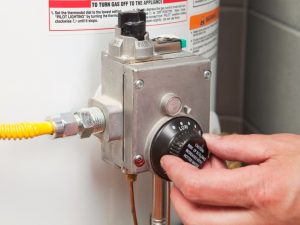LIFESPAN OF A WATER HEATER. IS IT TIME TO REPLACE YOURS?
On average, homeowners probably don’t give a second thought about the lifespan of a water heater. That is, until they want to take a nice, warm shower, step inside and chillingly discover that it no longer works.
Depending on the age and condition of your tank, water heater repair may be enough to get it up and running again. However, there may be certain signs that the lifespan of your water heater is approaching its end.
THERE’S NO HOT WATER
Obviously, the main job of a water heater is to deliver hot water on demand
When it can’t, it could be due to:
Corrosion in the dip tube: A pipe that sends cold water to the bottom of the tank where it gets heated.
Overloaded gas valve: This element sends gas to the pilot light and the main burner; it’s also a safety hazard if it isn’t working properly.
Compromised electrical elements: The components that actually heat your water courtesy of electrical resistance.
THERE’S A LEAK SOMEWHERE
Leaks are a sure sign the lifespan of a water heater is coming to its conclusion
These are commonly found in older unmaintained water heaters (around 10-12 years old). If you know there’s a leak but can’t actually find it, it’s usually located:
In the sidewall seam: Repairing a hot water tank sidewall involves removing the problem area, looking for any damage inside and fabricating a new sidewall piece to install back on.
At the welded joints: By nature, the weakest parts of a hot water system are the welded joints. Due to regular usage, leaks will start to emerge from these areas.
Near rusted threads: Over time, the constant exposure to hot and cold water will cause threads to rust.
GAS PILOT NEVER STAYS LIT
The gas pilot is kind of a big deal for your water heater. Without it, the burner inside that tank won’t ignite. In turn, the water inside the tank won’t heat up.
The tip of the thermocouple no longer sits inside (around half an inch) the pilot flame. That gap between the flame and the tip prevents the thermocouple from keeping the pilot valve open.
If the thermocouple is in the right place and the pilot still goes out, there’s something wrong with it.
If you replace the thermocouple and the pilot goes out, it’s the electromagnet that’s not working (requiring a new gas valve).

Are Tankless Water Heaters Worth The Investment?
What are the Pros and Cons of Tankless Water Heaters?
One of the worst starts to your day is trying to get ready for work and getting a cold shower because someone else used all the hot water. It takes a good amount of time for the tank to fill back up, turn on the burner, and heat the water. By then, you’ve already left for the day.
Additionally, the water cools and is re-heated in the tank several times each day while no one is home. This is just wasting energy and running up your utility bills. Some of these issues can be addressed by installing a tankless water heater. Endless hot water and lower energy bills are two reasons homeowners are switching to tankless water heaters.
Tankless water heaters save money in the long run, but initial costs are higher than tank models.
Endless hot water, additional storage space and lower energy bills are just a few reasons homeowners are switching to tankless water heaters.
But those perks may not be enough for some people to offset the extra purchase cost and installation expense. The U.S. Department of Energy estimates gas-fired tankless heaters save an average of $108 in energy costs per year over their traditional tank counterparts, while electric tankless heaters save $44 per year.
Tankless water heaters cost up to three times more than storage heaters — from less than $1,000 for an electric, whole-house model to $3,000 for a gas-powered one, including installation by a qualified plumber.
Helpful Safety Tips To Prevent Carbon Monoxide Leaks
Do you have natural gas or Propane appliances? Did you know current Plumbing code requires CO (Carbon Monoxide) Detectors within 10 feet of all sleeping rooms? These requirements are in place to help notify you in case of a gas leak or emergency.
The Dangers Of Carbon Monoxide
“In addition to fire risks, carbon monoxide (CO) poisoning can also result from improper home heating practices. CO often called “the silent killer,” is a gas you cannot see, taste, or smell. It can be created when fuels do not burn properly. Sources of carbon monoxide in the home can include oil and gas furnaces, gas water heaters, wood and gas fireplaces, gas ranges and ovens, gas or kerosene space heaters, and wood stoves. A person can be poisoned by a small amount of CO over a longer period of time or by a large amount of CO over a shorter amount of time.”
Helpful Safety Precautions You Should Utilize Include:
– If the pilot light of your gas heater goes out, allow five minutes or more for the gas to go away before trying to relight the pilot. Follow manufacturer’s instructions when relighting the pilot. Do not allow gas to accumulate, and light the match before you turn on the gas to the pilot to avoid the risk of flashback.
– If you smell gas in your gas heater, do not light the appliance. Leave the home immediately and call your local fire department or gas company.
– CO alarms and smoke alarms should be installed on every level of the home. See the manufacturer’s instructions for exact placement and location.
– All heaters need space. Keep anything that can burn at least three feet away from heating equipment.
– Have heating equipment and chimneys cleaned and inspected every year by a qualified professional.
– Purchase and use space heaters that have an automatic shut-off—if they tip over, they shut off.
– Place space heaters on a solid, flat surface. Keep them and their electrical cords away from things that can burn, high traffic areas, and doorways.
– Remember to turn portable heaters off when leaving the room or going to bed.
– Always use the right kind of fuel – specified by the manufacturer, for fuel-burning space heaters.
– Never use your oven to heat your home.
– Burn only dry, seasoned wood in fireplaces and woodstoves. Never burn garbage or use flammable liquids to start a fire.
– Make sure the fireplace has a sturdy screen to stop sparks from flying into the room. Ashes should be cool before putting them in a metal container. Keep the container a safe distance away from your home
– Install wood burning stoves following manufacturer’s instructions or have a professional do the installation. All fuel-burning equipment should be vented to the outside to avoid CO poisoning.
Frequently Asked Questions (FAQ)
How does a solar water heater work?
A solar geyser relies on solar power, which is a source of renewable energy, to work. For a solar water heater to work it requires a set of solar collectors to absorb the solar energy. These collectors are then connected to an insulated tank that stores the hot water. When the sun is out, water is heated in the solar collectors which is then pumped or flown automatically through the thermosyphon principle to the storage tank.
Why should I choose a Solar Water Heater? How much can I save if I use one?
As a solar geyser works on solar power, it cancels out the need for electricity. Let’s take for example a solar water heating system that has a 100 litre per day capacity. This solar geyser saves up to 1500 units of electricity in a year. However, this is subject to the amount of hot water that has been generated. But what’s more important is that it can also save around 140 litres of diesel thereby reducing CO2 emissions. A solar water heater is very useful in areas that experience power cuts. As this solar water heating system is designed with a storage unit, it can provide hot water as and when required. A solar water heater is an one time investment and a lifetime of savings because it runs on the principle of renewable energy.
For how long does the water from a solar geyser remain hot?
As the tank in a solar water heater is insulated with high-density injected PUF insulation, it ensures maximum heat retention. PUF with insulation properties is twice as effective as any other insulation material. This guarantees that the water remains relatively hot.
Does a solar geyser heat water during the winter season and on cloudy days?
With solar geyser, you will be able to enjoy warm water even during the colder months or when the sky is cloudy. This is due to the diffused radiation readily available in the atmosphere. During winter season, if there is clear sunlight, the water will be hotter. One way of ensuring hot water and direct sunlight throughout the year is by positioning the solar water heater correctly at the time of installation.
Do I have to change plumbing at my place to install and use solar water heater?
No, since solar water heaters are generally installed on rooftops or open grounds (where direct sunlight is available) you are not required to make any plumbing changes.

Rental Water Heaters
Choosing the Right Water Heater
There are a few decisions you’ll need to make when you replace your hot water heater, including:
Tank or tankless?
Gas or electric?
What size?
Rent or buy?
Water Heater + Water Softener Bundle
Your choice of gas or electric, tankless or conventional rental water heater
water softener rental
Free standard installation, maintenance and repairs
Clean and comfortable
Keep the comfort and the savings flowing round the clock — with a water heater plus water softener bundle.
Looking for a Quality Air Conditioner?
Air conditioner prices can vary depending on your needs and the size of your home, but you can also keep costs down by managing your energy use. There are many ways to save on your energy bill through your central air conditioner. Some factors that impact air conditioning costs include your thermostat setting, replacing old air conditioners, and selecting an energy-efficient air conditioner with a high SEER rating.